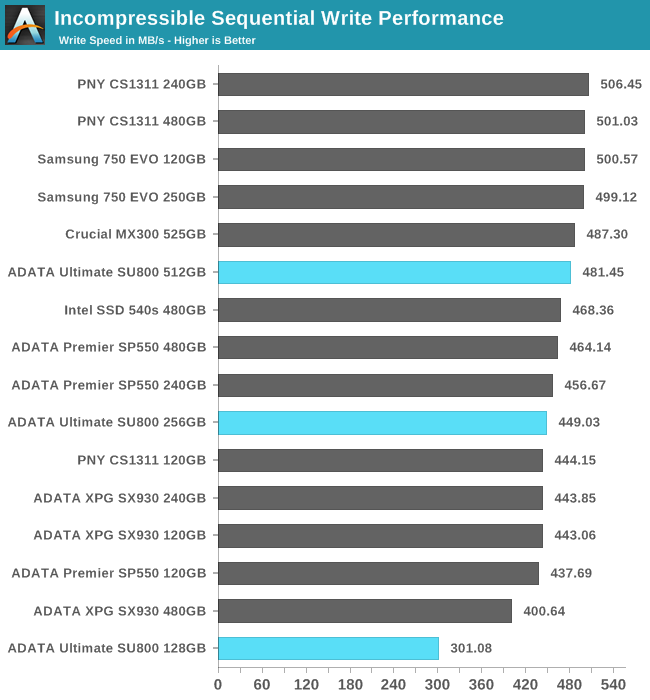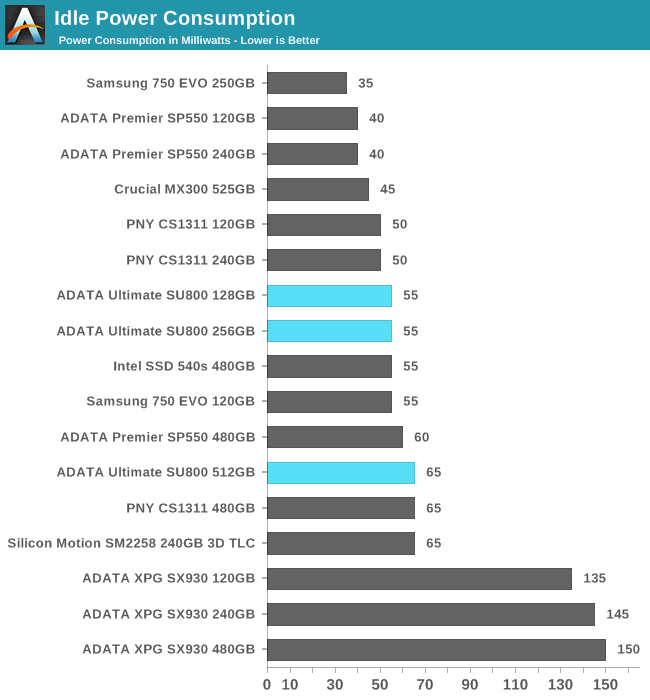The ADATA Ultimate SU800 SSD Review (128GB, 256GB, 512GB)
by Billy Tallis on February 1, 2017 12:01 PM ESTATTO
ATTO's Disk Benchmark is a quick and easy freeware tool to measure drive performance across various transfer sizes.
 |
|||||||||
The inferior write speed of the smallest SU800 is quite clear from the ATTO plots, but there are no other major issues revealed by this test.
AS-SSD
AS-SSD is another quick and free benchmark tool. It uses incompressible data for all of its tests, making it an easy way to keep an eye on which drives are relying on transparent data compression. The short duration of the test makes it a decent indicator of peak drive performance.


All three capacities of the SU800 deliver great sequential read speeds. The low write speed of the 128GB SU800 stands out even on this short test, but the larger capacities are only slightly behind their competition.
Idle Power Consumption
Since the ATSB tests based on real-world usage cut idle times short to 25ms, their power consumption scores paint an inaccurate picture of the relative suitability of drives for mobile use. During real-world client use, a solid state drive will spend far more time idle than actively processing commands. Our testbed doesn't support the deepest DevSlp power saving mode that SATA drives can implement, but we can measure the power usage in the intermediate slumber state where both the host and device ends of the SATA link enter a low-power state and the drive is free to engage its internal power savings measures.
We also report the drive's idle power consumption while the SATA link is active and not in any power saving state. Drives are required to be able to wake from the slumber state in under 10 milliseconds, but that still leaves plenty of room for them to add latency to a burst of I/O. Because of this, many desktops default to either not using SATA Aggressive Link Power Management (ALPM) at all or to only enable it partially without making use of the device-initiated power management (DIPM) capability. Additionally, SATA Hot-Swap is incompatible with the use of DIPM, so our SSD testbed usually has DIPM turned off during performance testing.


The ADATA SU800 achieves respectably low idle power when link power management is used. The active idle power consumption is a problem for all of the drives with Silicon Motion controllers, and worst for the SU800.










35 Comments
View All Comments
Arbie - Thursday, February 2, 2017 - link
@eek2121: Anandtech has changed most of its drive tests in the past two years, but it's easy to compare the Mushkin Reactor to this Adata in IOMeter 4KB random reads & writes. In these, the Mushkin is 50% faster. So please provide your basis for saying it's "drastically slower". While it may "soon disappear", that's been true for the past 18 months and it's still there, at $240. And FYI "clickbait" is the swathe of pandering pix labeled "From the Web". Anandtech provides these to raise its status as a on-line source of repute and save us the trouble of looking for garbage on our own.Billy Tallis - Thursday, February 2, 2017 - link
The Mushkin Reactor was one of the last drives tested with our 2013 test suite. Even though we used IOmeter back then, the test protocol was different. The 4kB random access numbers reported in that review were for QD3 using an 8GB test file, while our current 2015 test suite uses a 16GB file for random writes and the whole drive for random reads, and the score reported is the average of QD1, QD2, and QD4 performance. If the numbers were directly comparable, we'd be directly comparing them.TheinsanegamerN - Thursday, February 9, 2017 - link
"drastically"A few thousand IOPS is "drastically" now eh? For this market, they would never notice the difference.
eek2121 - Wednesday, February 1, 2017 - link
What is so click-baity about this? It's a review. Did you bother reading it? They came to the same conclusion you did. It's not that great. The Mushkin Reactor has been discontinued, why would they include it?lopri - Thursday, February 2, 2017 - link
That drive is not faster than what is benched. MLC does not automatically make a good SSD.Having said that, I do sometimes think AT neglect hardware of the past in their review, which is regrettable. Consumers not only compare current products but also upgrade their old gears, and they want to see if it is a worthy undertaking.
fanofanand - Wednesday, February 1, 2017 - link
Some might say I am being greedy or unrealistic, but I think that when SSD's hit 1TB for under $100, then we will finally be able to put the axe in mechanical hard drives with the exception of the 10+ TB drives for archiving or media libraries. If I could pick up a 2TB for under $200 I would buy it today. We are so close, yet so far.Great_Scott - Wednesday, February 1, 2017 - link
1TB drives were around $200 6 months ago.Most people seem to have around 3TB of data, not including any bloated Steam libraries, $600 over the course of a year (late 2015 to late 2016) seems reasonable, it's what I did.
Of course, the recent price increase probably blindsided most people, but if it was made a priority many enthusiasts don't need to be using spinning rust pretty much regardless of non-archive non-media (bulk) data.
But I keep seeing posts like yours. Does everyone want to only use 1 SSD in thier PC for some reason?
Laststop311 - Wednesday, February 1, 2017 - link
You have to not include blu ray disc image libraries either. I have a 6 bay NAS with 6x 4TB in raid 5 giving me 20TB of space 10TB of that is gone from 200 blu ray disc images and another 5TB from FLAC audio. When I have to upgrade all my disc images to 4k blu ray disc images they double in size + i will have more fo them. I will have to rebuild my nas with 6x 12TB drives at that point. So plenty of enthusiasts will still need spinning rust. For my next PC tho I plan on using a 128-256GB optane drive for the OS and most used productivity apps and VLC media player and chrome and my favorite couple games. A 1TB nvme drive for the majority of my most played games and 2x 2TB SATA 3 2.5" SSD's that my torrents will download onto and seed for awhile before being moved to the NAS or installed on a faster drive or deleted.The_Assimilator - Thursday, February 2, 2017 - link
"Does everyone want to only use 1 SSD in thier PC for some reason?"Why use a whole bunch of drives if you can only use 1? Saves on cable clutter, physical space (important for the rise in SFF systems) and just makes things simpler overall. Personally I can't wait for 4TB SSDs to become mainstream in price so that I can replace my mechanical disk.
JimmiG - Thursday, February 2, 2017 - link
I have about 1.2 TB of SSD storage spread over 240 GB, 480 GB and 500 GB SSD's, bought in the last couple of years. 1.2 TB in a single drive would be much more convenient since you wouldn't have to juggle your game installations and other files to keep the amount of free space on each SSD reasonable and balanced.After I got a NAS, I only have an old 1 TB HDD (in addition to the SSDs) in my PC for general data storage and less frequently used applications and games. I don't think "spinning rust" is going anywhere, but I think the smaller capacities (<3TB) are going away. People want them for bulk storage in NAS devices or as external USB drives.